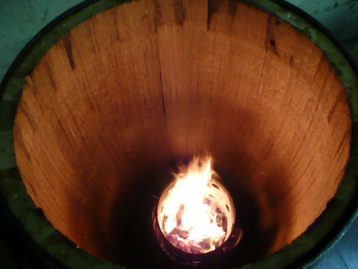 Barrels often get a bad rap. But the bad taste you have in your mouth isn’t necessarily the barrel’s fault. The barrel might be overused or misused, or the cooper didn’t use the right techniques when making the barrel. Sometimes it’s the wine’s fault. A barrel shouldn’t be expected to cover up flaws or compensate for something severely lacking in a wine. A barrel cannot perform miracles. It cannot make a bad wine great. But it can make a good wine even better.
Barrels often get a bad rap. But the bad taste you have in your mouth isn’t necessarily the barrel’s fault. The barrel might be overused or misused, or the cooper didn’t use the right techniques when making the barrel. Sometimes it’s the wine’s fault. A barrel shouldn’t be expected to cover up flaws or compensate for something severely lacking in a wine. A barrel cannot perform miracles. It cannot make a bad wine great. But it can make a good wine even better.
Here are some of the positive influences oak can have on a wine:
Body: adds weight and roundness to a wine
Texture: softens tannins, reduces astringency and gives the wine a silky or creamy texture
Complexity: adds flavors and aromas to the wine
If a barrel is overused, meaning there is too high a percentage of new oak, the barrel flavors overpower the wine and all you taste is the barrel. The first time a barrel is ever filled with wine is when it imparts the most flavors. To keep a wine balanced, a winemaker will use a percentage of new oak, often less than 50, and the rest of the wine will be aged in one-year or two-year old barrels.
My previous employer, the famous barrel broker Mel Knox, likes to joke, “A wine is never over-oaked. It is under-wined.” There is some truth to this in that the amount of new oak a wine can handle often depends on the wine. For example, a lighter bodied wine such as Pinot Noir can be overpowered by more than 30% new oak, but a heavier wine such as a Cabernet Sauvignon can handle 40%, 50% or more new oak. It’s important to have both the wine and barrel in balance. But the wine should always be the star and the barrel the supporting cast.
Finding the right balance is not easy though. What happens when wine, oak and oxygen come together is a series of chemical reactions dependent on a multitude of variables: the wine (grape variety, vineyard, alcohol level), winemaking choices (percentage of new oak, period of ageing in oak) and the oak itself. Let’s just look at the oak part of the equation. Here are a few things the winemaker needs to consider when choosing a barrel, or cooper:
-species and grain type (Quercus sessiflora, tight grain, wide grain)
-place of origin (French, American, Hungarian, a particular forest)
-toast levels (medium, medium-plus, heavy)
-years of air-drying the staves (“seasoning”)
-size (standard sizes are 225L and 228L but can range from 57L up to a 50,000L tank)
American oak has stronger flavors and aromas than French oak, usually more vanilla and perceived sweetness. Toasting affects the spectrum of flavors and aromas. The structure of the wood actually changes during the heating process and different chemical compounds are released or broken down. A medium toast barrel might show more vanilla, cinnamon, cocoa and spice, while the heavy toast barrel shows more caramel, roasted coffee, chocolate and smoky flavors. Air-drying staves decreases bitterness and astringency, revealing some of the sweeter flavors. Wines higher in alcohol tend to extract specific components from the barrel, not always the preferred traits.
Because of this ongoing list of variables, it’s not surprising that barrels are so often misused or misunderstood. It’s hard to get it just right. But don’t always blame the barrel.
